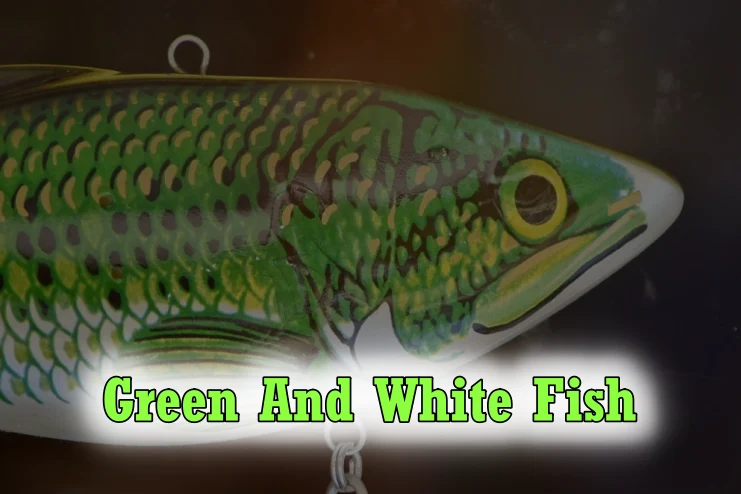The underwater world presents a realm of unparalleled beauty and grace. Amidst the many mesmerizing and captivating wonders beneath the Earth’s surface, there exists a stunning species of fish with a blend of green and white colors adorning their bodies.
Today, we bring you the top 10 green and white fish from around the world for you to get to know and discover!
Green and White Fish List
1) Green Tiger barb

| Scientific name | Puntigrus tetrazon |
| Diet | Processed and live food |
| Size | 7-10 cm |
| Location | Parts of Asia |
The green tiger barb, also known as the moss green tiger barb, can vary in its shade of green, sometimes appearing nearly black.
They are characterized by a silver to brownish-yellow body with four vertical black stripes and vibrant red fins and snout.
This unique combination of green and white along with black and red makes them stand out.
In the wild, tiger barbs are found in the clear or turbid shallow waters of streams.
They prefer a water pH level ranging from 6.0 to 8.0 and a temperature range of 25-27.8°C.
Tiger barbs are very active and are best kept in groups of six or more to reduce their aggressive tendencies.
2) Green humphead parrotfish
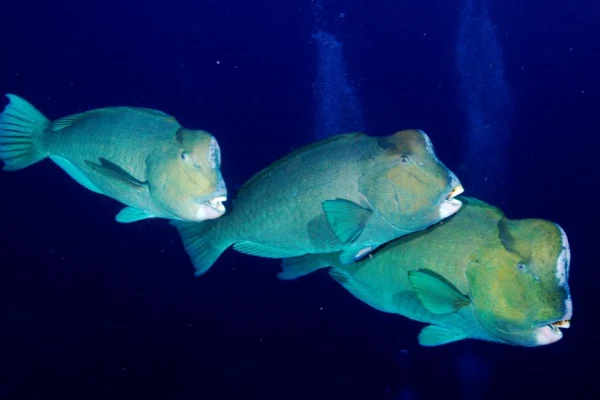
| Scientific name | Bolbometopon muricatum |
| Diet | Benthic algae and live corals |
| Size | <1.5 m |
| Location | Indian and Pacific Oceans |
Unlike the many green and white fish, the green hump head parrotfish are not typically kept as a pet due to its conservation status and specialized care requirements.
The green hump head parrotfish is the largest species of parrotfish with scales that can range from light green to pink.
In its primary phase, the scales appear as a dull gray with scattered white spots, gradually transitioning to a uniform dark green.
They also have a very intriguing feeding behavior. The adults are known to ram their heads against corals to facilitate feeding.
3) Green Rasbora
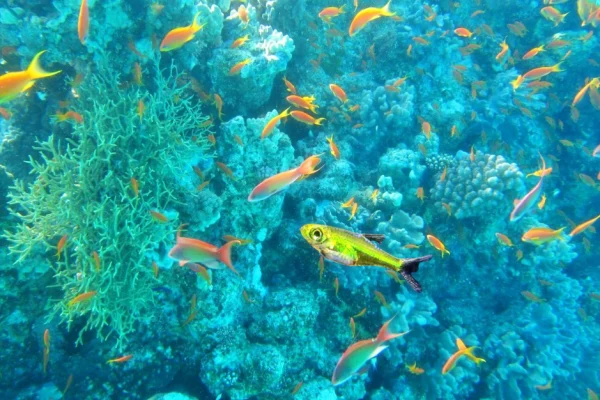
| Scientific name | Microdevario kubotai |
| Diet | Flake foods and algae wafers |
| Size | ~1.9 cm |
| Location | Myanmar and Thailand |
Neon Green Rasboras are known for their eccentric and eye-catching green and yellow coloration.
Their bodies are primarily green with hints of yellow, along with a white belly.
If you are planning to keep them in your aquarium it is important to provide a planted tank with ample vegetation and dark substrate to help create an environment where they feel safe.
Neon Green Rasbora is a peaceful and timid fish making it easy for them to mingle in an aquarium with other peaceful species like rasboras, tetras, and danios.
4) Green spotted pufferfish
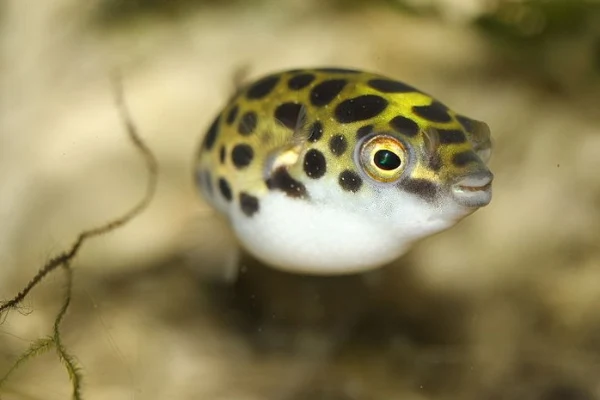
| Scientific name | Dichotomyctere nigroviridis |
| Diet | Snails, small crustaceans, and planktons |
| Size | 15-17 cm |
| Location | Southeast Asia |
Green spotted pufferfish showcases a beautiful pattern that resembles a beautiful mosaic of green and black, creating a visually appealing appearance.
The belly of the fish is white, while its fins and tail exhibit a light green hue. This vibrant and eye-catching coloration makes them a great choice for your aquarium.
Despite being known for their territorial and aggressive nature, green-spotted pufferfish are popular in the aquarium trade.
In the wild, green spotted puffers are found in freshwater streams, rivers, flood plains, and mangrove forests.
5) Emerald catfish
| Scientific name | Corydoras splenden |
| Diet | Worms, benthic crustaceans, and insect larvae |
| Size | 7.5 cm |
| Location | Amazon Basin |
Rightfully named, the body of the Emerald catfish has different shades of metallic green, blue-green, or even a bluish hue.
Due to their peaceful and rather timid nature, they are well-suited for freshwater aquariums alongside other non-aggressive fish species.
The female Emerald catfish collect the eggs in their pelvic fin baskets and attach them individually to plants or other objects in the tank.
Unlike some species, the parents do not immediately attempt to eat the eggs.
If you want to give your Emerald catfish a homely feel, it is recommended to have dense vegetation along the bottom of the aquarium.
6) Green terror
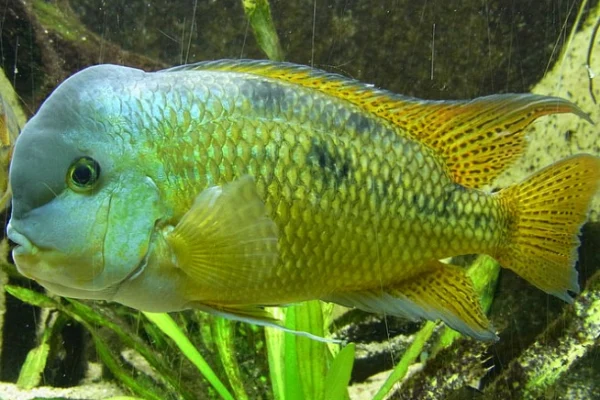
| Scientific name | Andinoacara rivulatus |
| Diet | Blood worms, krill, and brine shrimp, as well as green vegetables, and plankton |
| Size | 12-30 cm |
| Location | Pacific side of South America |
The green terror exhibits a wonderful coloration, with green, blue, and orange hues on the body of adult specimens.
Adult males develop a prominent forehead hump, adding to their distinctive appearance.
While not all, some individuals do exhibit an aggressive nature. Therefore, tankmates should be chosen carefully to prevent conflicts.
Green terrors have also been used as models in scientific research, particularly in studies related to the effects of testosterone on lateralization.
They are hardy and adaptable and their playful and unique characteristic, make them a popular choice for experienced aquarists.
7) Zebrafish
| Scientific name | Danio rerio |
| Diet | Zooplankton, phytoplankton, insects, and insect larvae |
| Size | 1.8-5 cm |
| Location | South Asia |
Zebrafish are known for their striking appearance, characterized by five horizontal, pigmented, bluish-green stripes that run along the sides of their bodies.
These stripes resemble the stripes of a zebra, hence the name “zebrafish.”
Their hardiness, adaptability, and playful behavior make them excellent pets, especially for beginners, but experienced aquarists wouldn’t mind having some for themselves.
Under optimal conditions, they can spawn frequently, sometimes even daily.
Like the green terror, zebrafish is utilized in scientific research.
Their transparent embryos and the ability to produce transgenic strains have made them valuable tools in genetics.
8) Green Chromis
| Scientific name | Chromis viridis |
| Diet | Phytoplankton, zooplankton, and algae |
| Size | 10 cm |
| Location | Indo-Pacific region |
The Green Chromis exhibits a captivating apple-green and light blue coloration.
They also feature and beautiful shiny silvery-white hue creating a beautiful contrast with the green and blue coloration adding to its visual appeal in aquariums.
It is well-suited for reef tanks, as it tends to inhabit coral reefs and lagoons in the wild.
Due to its hardiness, adaptability, ease of care, and affordability, it makes for a great choice for novice and experienced aquarists.
9) Valentin’s sharp nose puffer
| Scientific name | Canthigaster valentine |
| Diet | filamentous green and red algae, tunicates, and corals |
| Size | 11 cm |
| Location | Indian Ocean, Red Sea, and Pacific Ocean |
Valentin’s Sharp Nose Puffer showcases a beautiful combination of colors.
The body displays an iridescent apple-green and white hue adorned with distinctive black stripes on its back.
Its green and white coloration stands out against the backdrop of coral reefs and adds vibrancy to the tank and underwater.
These puffers are highly toxic making them unpalatable for the predators.
Their defense mechanism has also influenced the other fish to mimic their behavior to evade predators.
Hence, it is important to keep in mind the potency of their toxins when considering them as pets.
10) Vagabond butterflyfish
| Scientific name | Chaetodon vagabundus |
| Diet | Algae, coral polyps, crustaceans, and worms |
| Size | 15-23 cm |
| Location | Indo-Pacific region |
The vagabond butterflyfish features a whitish body adorned with a captivating V-shaped pattern. Additionally, there are thin orange horizontal lines over its forehead, adding to its visual appeal.
Along with this unique coloration, they also feature a vibrant lime-green tail with black and grey coloration towards the inner part.
They display a certain kind of monogamy with their partner and showcase aggressive behavior when needed.
When it comes to feeding, they often accompany other fish species without displaying excessive aggression, making them relatively easy to maintain in aquariums.
Conclusion:
This marks the end of yet another article in the series discovering the wonderous works of nature. As we learn more about how beautifully and creatively each creature protects itself and survives, let us also remember and make it our mission to be conscious of the decisions we make as their cohabitant.
References:
- https://en.wikipedia.org/wiki/Valentin%27s_sharpnose_puffer
- https://en.wikipedia.org/wiki/Vagabond_butterflyfish
- https://en.wikipedia.org/wiki/Chromis_viridis
- https://en.wikipedia.org/wiki/Emerald_catfish
- https://aquadiction.world/species-spotlight/neon-green-rasbora/
- https://en.wikipedia.org/wiki/Dichotomyctere_nigroviridis
- https://en.wikipedia.org/wiki/Tiger_barb
- https://en.wikipedia.org/wiki/Green_humphead_parrotfish
- https://en.wikipedia.org/wiki/GloFish
- https://en.wikipedia.org/wiki/Green_terror
- https://en.wikipedia.org/wiki/Zebrafish
Also Read:

Hi everyone, my name is Shawna, and I’ve always been fascinated by the fascinating diversity of flora and fauna that our nature has in it. I am currently studying biotechnology and am particularly interested in animal biotechnology, delving into the intricate processes that define their true nature and uniqueness.
